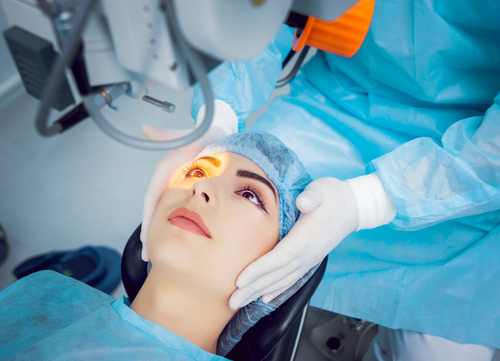Posted by: Clear Advantage in Uncategorized on July 11, 2025
Have you been diagnosed with keratoconus? While glasses and contact lenses can provide a temporary solution to your vision problems, they cannot prevent the condition from worsening.
Luckily, recent advances in keratoconus treatment, like corneal cross-linking, have been shown to improve patient outcomes by slowing or even stopping the progression of the condition. Keep reading to learn more about how eye doctors are using advanced technology to treat keratoconus and whether this treatment could be right for you.
What is Keratoconus?
Your cornea is the clear, dome-shaped structure at the front of your eye responsible for focusing light onto the retina for clear vision and protecting your eye from debris. Keratoconus is a condition in which the cornea progressively bulges outward into a cone-like shape.

This often causes symptoms like:
- Irregular astigmatism
- Nearsightedness
- Worsening, blurry, or distorted vision
- Light sensitivity
- Halos around lights
- Double vision
Most keratoconus cases are found in adults in their 20s and 30s, but they can start developing earlier in childhood or teenage years as well. While the cause is unknown, some studies have linked keratoconus to conditions associated with chronic eye rubbing, like allergic rhinitis, Down syndrome, and asthma.
Left untreated, your cornea will likely become steeper and steeper, making it more difficult to see the longer you have keratoconus. It can also result in complications like corneal scarring, Fleisher rings, or corneal hydrops.
However, advances in keratoconus technology, like corneal cross-linking, can help preserve your vision and prevent these complications.
What is Corneal Cross-Linking?

Previously, treatments for keratoconus were largely limited to temporary solutions like glasses and contacts or more extreme treatments like corneal transplantation, which carries risks of serious complications. Advances in technology have led to the creation of corneal cross-linking, a less invasive procedure that can slow or permanently stop the progression of keratoconus and prevent the need for a corneal transplant in the future.
Corneal cross-linking works by using ultraviolet (UV) light and riboflavin (vitamin B2) eye drops to stimulate new bonds between collagen fibers in the cornea. This strengthens its structure, preventing it from bulging further.
While corneal cross-linking cannot reverse existing vision damage, it can stop the progression of the condition. Clear Advantage Vision Correction Center is proud to be the first practice in the state of New Hampshire to offer this state-of-the-art treatment to patients.
What to Expect During Corneal Cross-Linking
To begin the corneal cross-linking procedure, your ophthalmologist at Clear Advantage Vision Correction Center will remove the epithelium or outer layer of your cornea. This is done under local anesthesia, meaning you’ll be awake during the procedure, but you won’t feel any pain.
They will then apply riboflavin (vitamin B2) eye drops to the cornea, where it will absorb for 30 minutes. Your eye doctor will apply a targeted UV light onto your eye to activate the riboflavin.
This chemical reaction generates new collagen bonds between fibers in your cornea, fortifying it to prevent further bulging. Corneal cross-linking takes about two hours in total and is completed in the office.
The majority of patients can resume work and normal activities within 24-48 hours, but still need to follow certain precautions until the epithelium has fully regrown.
Is Corneal Cross-Linking Right for Me?

Good candidates for corneal cross-linking typically have mild to moderate keratoconus or other corneal ectasia-related conditions. You will need to attend a consultation with your eye doctor at Clear Advantage Vision Correction Center to determine if the procedure is right for you.
They will ask about your symptoms, examine your eyes, measure your cornea, review your medical history, and ask about your lifestyle and vision goals to determine the best course of treatment for you. However, you may not be a good candidate for corneal cross-linking if:
- You have dry eye syndrome
- You are pregnant or breastfeeding
- You have corneal scarring
- You have a history of ocular herpes
- You have certain autoimmune conditions
- Your corneas are thinner than 400 microns
These factors could make the procedure unsafe or ineffective for your eye health and vision.
Is Corneal Cross-Linking Covered By Insurance?
Most medical insurance providers consider corneal cross-linking “medically necessary” to treat keratoconus. This means that your insurance will likely cover your evaluation, procedure, and post-operative follow-up visits.
Will I Still Need Glasses after Corneal Cross-Linking?
If you wore glasses or contacts to correct your vision before undergoing corneal cross-linking, you will likely still need to wear them after the procedure. This is because, while corneal cross-linking can prevent your vision problems from worsening, it cannot correct existing ones.
The primary goal of corneal cross-linking is to slow or stop changes to the cornea, improve your long-term visual prognosis, and prevent the need for more invasive procedures like corneal transplantation.
Do you have keratoconus and want to learn more about advanced solutions like corneal cross-linking? Schedule an appointment at Clear Advantage Vision Correction Center in Portsmouth, NH, today to find out whether the procedure could be right for you!






